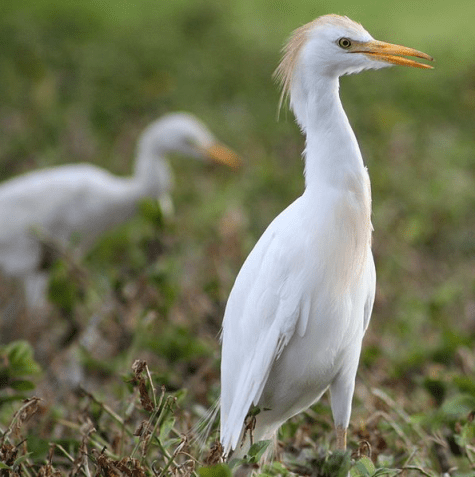
BY SYD SINGER – I am a medical anthropologist, author, and director of the Institute for the Study of Culturogenic Disease, located in Pahoa, Hawaii. We study how certain cultural attitudes and behaviors can lead to sickness.
The proposed rule change, which essentially encourages the eradication of introduced cattle egrets and barn owls in Hawaii, will exacerbate current racial tensions existent in current Hawaiian society.
While Hawaii is portrayed as a melting pot to the world, the reality is that there is deep rooted racial and cultural antagonism from local and native groups against immigrant groups, the latter pejoratively referred to as “haole”. Bullying in schools and at the workplace by “locals” against immigrants, usually Caucasian, is a big problem in Hawaii.
One of our areas of concern has been the impact of invasive species control on these human interactions. Fundamentally, the invasive species issue an anti-immigration policy, supported by a sentiment that certain immigrant species “don’t belong in Hawaii”, and are competing with local species for resources and space. Of course, this same sentiment is expressed against human immigrants.
The fact is, environmental policy mirrors political policy. Xenophobia in the political world, with our current immigration crisis, is mirrored by bio-xenophobia, a fear of immigrant species.
Killing immigrants to return a culture to pre-contact conditions is called genocide and ethnic cleansing. Killing cattle egrets and barn owls to return the environment to pre-contact conditions is species cleansing, and a genocide against these wonderful creatures.

We must find nonlethal solutions to the impacts of human and nonhuman immigration. Militant solutions that result in the killing of innocent beings, regardless of their species, is morally reprehensible and will lead to more violence.
As a nation that has been at war now for over a decade, we have become accustomed to killing and violence. Our streets are threatened by mobs with violent intent, punching out victims for pleasure. The victims, of course, of usually another race. Racist hatred runs deep in our culture, and the invasion biology agenda of cleansing ecosystems of immigrant species feeds this hatred.
I truly feel sorrow for the native and endangered species that cannot compete with these immigrant species for survival. We should be encouraging the rehabilitation of these species without having to harm other species whose sole fault is their success at surviving.
As climate change redefines environmental conditions, these hardy immigrant species may be better suited for survival in the changing world than the native species that are adapted to the conditions of the past.
We may lose our endangered and native species in addition to the species eradicated because they are nonnative.
The challenges to our endangered Hawaiian birds goes far beyond the impacts of cattle egrets and barn owls. The greater threats are development of wetlands and other wild spaces, pollution of the air and water and ground, climate change, and disease. Other predators include cats, rats, mongooses, dogs, and humans. Killing tens of thousands of cattle egrets and barn owls can increase local populations of other predators of these endangered birds, especially egg-eating rats.
Essentially, this is an experiment to see if killing massive numbers of cattle egrets and barn owls will help save endangered species. It is easy for a militant culture to use militant options when feeling frustrated with nonlethal methods. However, just as we insist on civility, compassion, and empathy when dealing with human immigrant issues and abhor violent measures, we must do the same with nonhuman immigrant issues.
We can level the playing field, improving the competitive edge for native and endangered species, by helping the weak, rather than by weakening the strong. We can embrace and value all life, native and immigrant, and find ways for co-existence. The alternative is war and its destructive influences. For the way we treat animals will be the way we treat people.
The public can comment until February 3, 2014 on the proposed rule changes by one of the following methods only:
• Federal eRulemaking portal: https://www.regulations.gov. Follow the instructions for submitting comments on Docket FWS–HQ–MB–2013–0070.
• U.S. mail or hand delivery: Public Comments Processing, Attention: FWS–HQ–MB–2013–0070; Division of Policy and Directives Management; U.S. Fish and Wildlife Service; 4401 North Fairfax Drive, MS 2042–PDM; Arlington, VA 22203–1610.
FOR FURTHER INFORMATION CONTACT:
Dr. George T. Allen in Arlington, Virginia, at 703–358–1825 about the proposed rule, or Jenny Hoskins in Volcano, Hawaii, at 503–382–7056 about the draft environmental assessment.


This proposal is insane and must be stopped !!!
Cattle Egrets and Stilts are coexisting very well in all of the parts of Oahu I visit to photograph both. I have never seen any situation that the very aggressive Stilts were disturbed by Egrets. They both roost on an island in the Hawaii Kai marina that I visit evey evening. They do not compete for anything. The few Stilts have many feeding spots and I never see them near Egrets in the areas. The Cattle Egret population has grown greatly this year – a wonderful thing ! They are beautiful birds that people should enjoy watching. Killing them will in no way increase the Stilt population. It would be a crime against nature.
Keep the birds, get rid of the government.
[…] Government Plans Extermination of Hawaii’s Cattle Egrets and Barn Owls […]
If it's a problem to the society and creates a danger to someone. Like flying across the H3 freeway and causing someone a life or going into an airplane engine and causing mass casualties to many loved ones. Then people that are appose to kill them might change there tune. But then it will be to late, it happen on the mainland already.
Comments are closed.